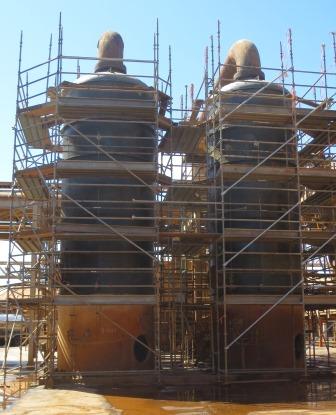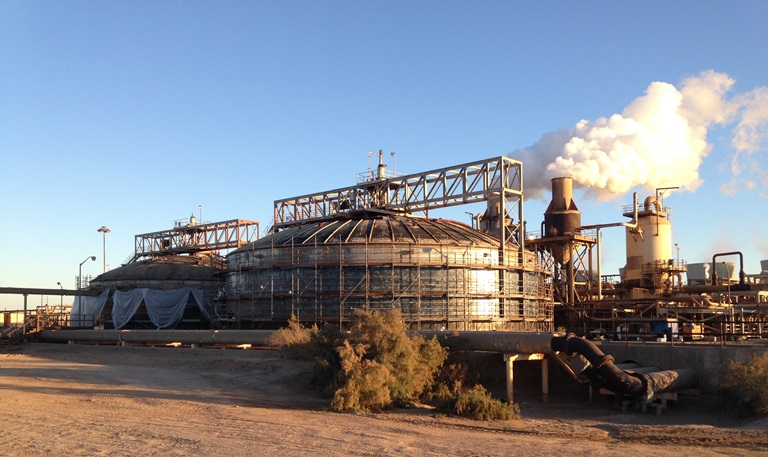When essential components of a large North American geothermal power plant were shown to have major steel loss, HJ3 Composite Technologies, LLC was called to the scene. HJ3 is a technology transfer from the University of Arizona that has been providing clients with comprehensive infrastructure repair and strengthening products for the last decade. HJ3 determined that the damaged components at the plant needed to be rehabilitated and coated with specialized products, also from HJ3. The client got an all-inclusive solution from this coatings crew!
The 411 on Geothermal Power Plants
According to Adrienne Barela, marketing manager at HJ3, geothermal plants are unlike most other power plants that rely on coal or other fossil fuels to generate electricity. “Geothermal plants rely on the Earth’s natural heat. Steam or very hot water flows to the Earth’s surface from 5,000 to 10,000 feet (1.5–3 km) underground via drilled production wells. It is then used to turn large turbines that power electrical generators,” explained Barela. Most geothermal plants are located in  the western United States and provide the fourth largest source of the United States’ renewable energy, after hydroelectricity, biomass, and wind power.
the western United States and provide the fourth largest source of the United States’ renewable energy, after hydroelectricity, biomass, and wind power.
Within the plant, there are many vital components that aid in turning the steam into a usable energy source. “Geothermal plants utilize primary and secondary clarifier tanks to separate geothermal brine from particulate material. Demisters are also used within pressure vessels in the plant to remove liquid droplets that get trapped in the gas streams,” said Barela.
One of the primary clarifiers at the geothermal plant was surveyed and had approximately 80 percent steel loss on its sidewalls, upper tank ring, and dome. According to Barela, the clarifier is 10,300 square feet (957 m²) in size, and corrosion had severely weakened its structural integrity. One of the demister vessels, which measures 3,800 square feet (353 m²), had also experienced major steel corrosion on the sidewalls of the upper tank rings and the dome, with an estimated steel loss of 90 percent. It was also found that a secondary clarifier tank, measuring 7,150 square feet (664 m²), was in poor condition. Structural reinforcement and protection against future deterioration of these components needed to occur as quickly as possible.
No Downtime
Once the scope of work had been determined, the eight-person HJ3 crew was ready to begin the repair and coating application process. However, shutting down the plant for the repairs was not an option. “The clarifier tanks and demister vessel were repaired at different times over the course of a few months to minimize interruptions to plant operations,” stated Barela. The demister vessel work was performed during a scheduled plant-wide shut-down, but no additional downtime was associated with the repair and coating installation.
Rules and Regulations
The first step in the rehabilitation process for each of the three components was to prepare the steel for the application of HJ3’s CarbonSeal coating system. The steel was prepared per NACE International No. 2/Society for Protective Coatings (SSPC) 10: Near-White Blast Cleaning. The blasting process had to be carefully thought out and the blast media used had to meet the regulations of the state in which the geothermal power plant resides. “Due to standards set by the state’s clean air agency, there were concerns with using traditional sandblasting media during surface preparation. HJ3 conducted a wet abrasive blast using the approved media per the agency’s requirements,” said Barela.
Once they wet abrasive blasted the steel substrate, the crew used dry compressed air to remove any remaining dust particles. Then they used a mechanical grinder on areas where the steel needed to be brought flush with the tank wall surface. Finally, they used acetone to wipe down and remove any loose or fine particles. The tank surface was also inspected for through-holes requiring repair prior to installing HJ3’s CarbonSeal carbon fiber repair system.
Time for the Installation
With the steel prepared and ready to go, the HJ3 crew got to work on the application of their specialized steel-strengthening repair system. The team used rollers to apply the CarbonSeal primer coat at a thickness of 5 mils (127 microns). “Priming was performed quickly to prevent flash rust from occurring,” explained Barela.
 HJ3’s High Modulus Paste was then applied with a roller to the primed substrate at a thickness of 20–25 mils (508–635 microns). One layer of HJ3’s CarbonSeal glass fabric was saturated and applied to the tank to provide cathodic protection. HJ3’s uni-directional CarbonSeal carbon fiber was then saturated and installed over the glass fabric. The basecoat portion of this system has a thickness of 35 mils (889 microns) and the carbon fiber has a thickness of 50 mils (1,270 microns).
HJ3’s High Modulus Paste was then applied with a roller to the primed substrate at a thickness of 20–25 mils (508–635 microns). One layer of HJ3’s CarbonSeal glass fabric was saturated and applied to the tank to provide cathodic protection. HJ3’s uni-directional CarbonSeal carbon fiber was then saturated and installed over the glass fabric. The basecoat portion of this system has a thickness of 35 mils (889 microns) and the carbon fiber has a thickness of 50 mils (1,270 microns).
At this point, it was time to apply HJ3’s CarbonSeal chemical and ultra violet (UV)-resistant topcoat. According to Barela, the CarbonSeal repair and coating application on the primary and secondary clarifier tanks, as well as the demister vessel, was designed to both strengthen the steel and protect the substrate from corrosive and abrasive elements and high temperatures.
The Heat Factor
One of the most challenging aspects of a job at a geothermal power plant is the high surface temperatures of the steel substrate. “This was a high-temperature repair with surface temps of 220° F [104° C] during the installation. The contents of the tanks and vessels were aggressive geothermal brine, and there were active leaks,” stated Barela.
Because the high temperature reduced the working time of the resins, the crew had to work quickly and efficiently. In addition, the heat was a major safety concern. “The crew wore insulated gloves and Tyvek suits to protect them from the hot surface. Also, since working in such extreme temperatures takes a toll on the workers, the installation was completed in rotating shifts, with crewmembers working for 45 minutes and then taking a 15-minute break,” explained Barela.
The heat was not the only safety consideration on the jobsite. Scaffolding was used to access the tanks, so fall protection was a must. Yo-yo lanyards were used and all crewmembers were tied off at all times. According to Barela, daily inspections of all scaffolding, equipment, and personal protective equipment (PPE) occurred. “The crew also wore hard hats, steel-toed boots, ear protection, respirators, and safety glasses in addition to their protective gloves and Tyvek suits,” said Barela.
Meticulous QC
Although this job was challenging, both in the physical application process and when it came to scheduling and logistics, it was ultimately a positive one. Barela attributes the effective and efficient completion of the project in large part to HJ3’s thorough quality control (QC) procedures. “In every single phase of the job, all variables were recorded and logged. From environmental and surface dew points, surface temperatures and ambient temperatures, to the mixing times of HJ3’s CarbonSeal coatings, everything was logged and recorded. We were able to catch anything that was off or not optimal right away. This ensured that all aspects of the installation were done the right way and in the right conditions,” said Barela. This was one coatings crew that could handle the heat.
